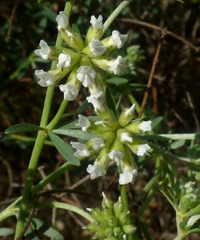Portuguese oak
Quercus faginea
Plantae Quercus faginea, commonly known as the Portuguese oak, is a deciduous or semi-evergreen tree native to the Iberian Peninsula, including the Comunidad Valenciana. Known locally as carrasca or quejigo, this species is well-suited to the Mediterranean climate of this region.
The following are key characteristics of Quercus faginea:
- Appearance: The tree typically grows to a height of 10-20 meters, with a trunk diameter of up to 1 meter. It features a rounded crown that provides ample shade.
- Leaves: The leaves are lanceolate or ovate, with a toothed margin. They are green on top and paler underneath, turning to a golden brown in the autumn.
- Bark: The bark is gray and becomes deeply fissured as the tree matures, providing a habitat for various epiphytes and insects.
- Acorns: Quercus faginea produces acorns that mature in one year, serving as a food source for wildlife such as birds, mammals, and insects.
- Habitat: This oak species thrives in mixed forests and woodlands, often found on limestone or siliceous substrates, and can tolerate both dry and moist conditions.
The Portuguese oak plays a vital ecological role in its native regions, offering habitat and sustenance to a variety of wildlife while also contributing to soil conservation and landscape stability. Its wood is valued for its strength and durability, often used historically for construction and crafts.







